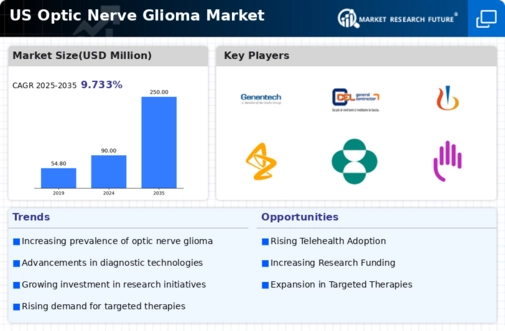Increased Research Funding
The surge in research funding for neuro-oncology is a critical driver for the optic nerve-glioma market. Government and private organizations are increasingly investing in studies aimed at understanding the biology of optic nerve gliomas and developing new therapeutic strategies. In 2025, funding for brain tumor research in the US is expected to exceed $100 million, reflecting a growing commitment to tackling these challenging conditions. This influx of resources is likely to accelerate the development of innovative treatments and improve patient outcomes, thereby expanding the optic nerve-glioma market. As research progresses, new insights may lead to breakthroughs that could significantly alter the treatment landscape.
Growing Awareness and Advocacy
The rise in awareness and advocacy for optic nerve gliomas is playing a pivotal role in shaping the market. Organizations dedicated to brain tumor research and patient support are increasingly active in educating the public and healthcare professionals about these tumors. This heightened awareness is likely to lead to earlier diagnosis and treatment, which can improve patient outcomes. Additionally, advocacy efforts are pushing for more funding and research initiatives, further driving the optic nerve-glioma market. As more individuals become informed about the condition, the demand for specialized care and innovative therapies is expected to rise, potentially leading to a market growth of 5-8% annually.
Technological Innovations in Treatment
Technological advancements in treatment methodologies are significantly influencing the optic nerve-glioma market. Innovations such as minimally invasive surgical techniques, advanced imaging technologies, and novel radiation therapies are enhancing treatment outcomes. For instance, the introduction of stereotactic radiosurgery has shown promising results in managing optic nerve gliomas, leading to improved patient survival rates. The market is projected to grow as these technologies become more widely adopted, with estimates suggesting a compound annual growth rate (CAGR) of around 7% over the next five years. This trend indicates a shift towards more effective and less invasive treatment options, which could reshape the landscape of the optic nerve-glioma market.
Rising Incidence of Optic Nerve Gliomas
The increasing incidence of optic nerve gliomas in the US is a notable driver for the optic nerve-glioma market. Recent data indicates that these tumors account for approximately 5-10% of all pediatric brain tumors, with a higher prevalence in children with neurofibromatosis type 1. This growing patient population necessitates enhanced diagnostic and therapeutic options, thereby stimulating market growth. As awareness of these tumors rises, healthcare providers are more likely to seek advanced treatment modalities, contributing to the expansion of the optic nerve-glioma market. Furthermore, the demand for specialized care and innovative therapies is expected to increase, potentially leading to a market valuation exceeding $500 million by 2030.
Collaboration Among Healthcare Providers
The trend of collaboration among healthcare providers is emerging as a significant driver for the optic nerve-glioma market. Multidisciplinary teams, including oncologists, neurologists, and radiologists, are increasingly working together to develop comprehensive treatment plans for patients. This collaborative approach not only enhances patient care but also fosters the exchange of knowledge and expertise, leading to improved treatment outcomes. As healthcare systems recognize the benefits of such collaboration, the demand for integrated care models is likely to grow. This shift could result in a more robust optic nerve-glioma market, with projections indicating a potential increase in market size by 10% over the next few years.

















Leave a Comment